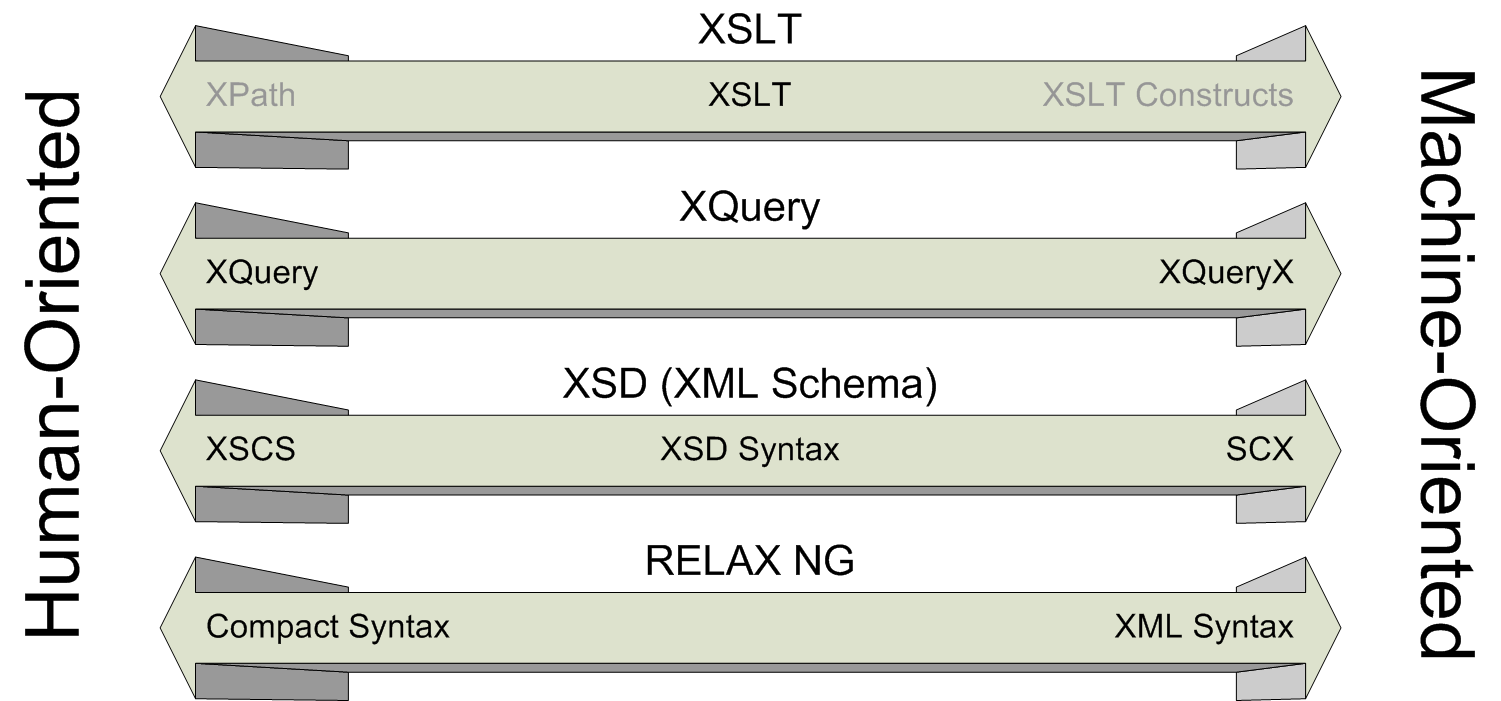(2) Abstract
Because XML can be used to represent any vocabulary (often defined by some schema), the question is how these different vocabularies can be processed and maybe transformed into something else. This something else
may be another XML vocabulary (a common requirement in B2B scenarios), or it may be HTML (a common scenario for Web publishing). Using XSL Transformations (XSLT), mapping tasks can be implemented easily. XSLT leverages XPath's expressive power in a rather simple programming language, the programs are often called stylesheets. For easy tasks, XSLT mappings can be specified without much real programming
going on, by simply specifying how components of the source markup are mapped to components of the target markup.
Simple Examples
(8) My First XSLT
- XSLT uses a simple environment
- all you need is an XSLT processor ( [http://www.saxonica.com/] recommended)
- Some interesting observations
- it is an XML document (using the [http://www.w3.org/TR/xslt#xslt-namespace])
- it contains no visible code (no statements)
- when being applied (i.e., executed), it produces a result
<?xml version="1.0" encoding="UTF-8"?>
<xsl:stylesheet version="1.0" xmlns:xsl="http://www.w3.org/1999/XSL/Transform">
</xsl:stylesheet>
(9) Why does it Work?
- The
text
of the document is produced- technically, it is the concatenation of all text nodes
- this works with all XML input documents
- XSLT by default traverses the document tree
- it copies all text nodes
- it works its way through the document recursively
- this behavior is unusual for a programming language
(10) My Second XSLT
<?xml version="1.0" encoding="UTF-8"?>
<xsl:stylesheet version="1.0" xmlns:xsl="http://www.w3.org/1999/XSL/Transform">
<xsl:output method="text"/>
<xsl:template match="/ | *">
<xsl:text>( Element: </xsl:text>
<xsl:value-of select="local-name()"/>
<xsl:apply-templates select="@* | *"/>
<xsl:text>)</xsl:text>
</xsl:template>
<xsl:template match="@*">
<xsl:text>Attribute: </xsl:text>
<xsl:value-of select="local-name()"/>
</xsl:template>
</xsl:stylesheet>
(11) How does it Work?
- Text output rather than XML output
- Overriding the default behavior
- new rules for how to recurse through the document tree
- the rules are
applied
by the XSLT processor - the execution of the XSLT code is controlled by the XSLT processor
- Traversing the document tree in XSLT is easy
- this is what XSLT has been designed for
- trying to avoid this pattern leads to bad code and bad results
(12) My Third XSLT
<xsl:output method="html"/>
<xsl:template match="/">
<html>
<head>
<title>Address List</title>
</head>
<body>
<table>
<xsl:for-each select="/people/entry">
<tr>
<td><xsl:value-of select="name/given[1]"/></td>
<td><xsl:value-of select="name/sur"/></td>
<td><a href="mailto:{email}"><xsl:value-of select="email"/></a></td>
</tr>
</xsl:for-each>
</table>
</body>
</html>
</xsl:template>(13) How Mappings Work
- All non-XSLT elements are literal result elements
- their content is processed as usual
- they may contain XSLT or literal result elements
- XSLT elements in the stylesheet are instructions
- they are executed and have some predefined behavior
- if they produce results, these go to the result tree as well
- One-template XSLT is a good way to start with XSLT
- avoiding the learning curve associated with Templates [XML Transformations (XSLT) – Part II; Templates (1)]
- for easy mapping tasks, this pattern often is sufficient
- for complex tasks, this is the XSLT equivalent of
spaghetti code
(14) Hello World
in XSLT
- XSLT always transforms an XML document
- this is hard-coded in the XSLT Processing Model [XML Transformations (XSLT) – Part II; XSLT Processing Model (1)]
- Simply generating output is impossible
hello world
therefore ignores the input- anything can be the input (including the XSLT itself)
<?xml version="1.0" encoding="UTF-8"?>
<xsl:stylesheet version="1.0" xmlns:xsl="http://www.w3.org/1999/XSL/Transform">
<xsl:template match="/">
<xsl:text>Hello World!</xsl:text>
</xsl:template>
</xsl:stylesheet>
XSLT Instructions
(16) XSLT is RISC
- XSLT has a [http://www.w3.org/TR/xslt#element-syntax-summary]
- the language was designed to run in a restricted environment
- the language was designed for a specific task
- much of the language's power lies in XPath
- XPath is the CISC part of XSLT
- XPath is a complex high-level language
- it is specialized for the task the language is designed to do
- it can be highly optimized
- writing the XPaths often is the most challenging part of XSLT
- Starting with XSLT should improve simple mappings
(17) Iterations
- XSLT can only iterate over node sets
- any other problem has to be solved recursively
- iterating over node sets often is what you want to do
- Applying the same code to all of the nodes
- works great if all nodes require the same processing
- is of limited use when processing needs to be conditional
<xsl:for-each select="/people/entry">
<tr>
<td><xsl:value-of select="name/given[1]"/></td>
<td><xsl:value-of select="name/sur"/></td>
<td><a href="mailto:{email}"><xsl:value-of select="email"/></a></td>
</tr>
</xsl:for-each>(18) Conditional Instructions
- Programming languages usually provide if-then-else
- XSLT has an if-then: if
- and an if-then-(elif-then)*-else: choose
- Simple handling of special cases
- having few and reasonably sized conditionals is ok
- having deeply nested and very long conditionals is a problem
- as in all programming languages, the latter case should user other mechanisms
(19) My Third XSLT (II)
<table>
<xsl:for-each select="/people/entry">
<tr>
<td><xsl:value-of select="name/given[1]"/></td>
<td><xsl:value-of select="name/sur"/></td>
<td>
<xsl:if test="email">
<a href="mailto:{email}"><xsl:value-of select="email"/></a>
</xsl:if>
</td>
</tr>
</xsl:for-each>
</table>(20) My Third XSLT (III)
<td>
<xsl:for-each select="phone">
<xsl:text>☎ (</xsl:text>
<xsl:choose>
<xsl:when test="@location = 'office'">Office</xsl:when>
<xsl:when test="@location = 'home'">Home</xsl:when>
</xsl:choose>
<xsl:text> </xsl:text>
<xsl:choose>
<xsl:when test="@type = 'voice'">phone</xsl:when>
<xsl:when test="@type = 'fax'">fax</xsl:when>
</xsl:choose>
<xsl:text>): </xsl:text>
<xsl:value-of select="."/>
<xsl:if test="position() ne last()">
<br/>
</xsl:if>
</xsl:for-each>
</td>![]() [http://creativecommons.org/licenses/by/3.0/]
[http://creativecommons.org/licenses/by/3.0/]